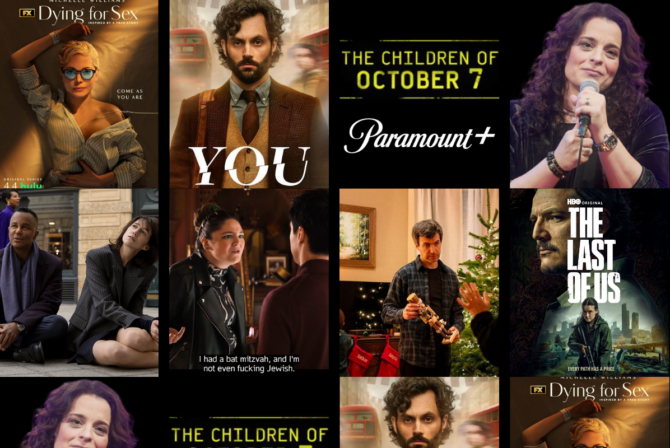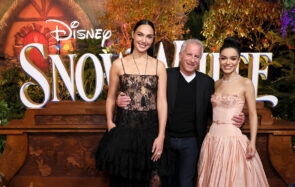Apple TV+’s “Lady in the Lake” is full of Jewish specificities, meticulously and hauntingly staged. The show stars Natalie Portman as Maddie Schwartz, or as she wants to be known, Maddie Morgenstern, a housewife hoping to find her freedom as a journalist while investigating the death of a Black woman, Cleo Johnson (played by the amazing Moses Ingram), who was found dead in the lake in 1960s Baltimore. There’s a visit to a bustling kosher butcher in which Schwartz argues with him about the virtues of her husband — is he a mensch or a macher? Ten-year-old Tessie Durst, whose killing is the first mystery that Maddie helps solve, and who attended the local Hebrew day school, shares that the only thing she knows about fish is that they were created on the 5th day, as it says in Genesis. There’s a synagogue benefit in which Maddie muses about the misogyny in Shacharit, the Jewish morning prayers in which men thank God for not making them a woman. In fact, Maddie’s marriage falls apart over a conflict about dairy and meat dishes, the two sets of dinnerware that many Jews who keep kosher use. And there’s a Hanukkah scene in which Portman perfectly enunciates whispered Hebrew blessings as Durst’s parents light the candles.
It’s striking to watch Portman, in her first TV project, play a complex Jewish character. Portman, born Natalie Hershlag in Jerusalem, didn’t change her stage name to sound less Jewish, but to separate her professional identity from her personal one when she was a child actress. She speaks Hebrew, has been open about the complexities of her Jewish and Israeli identity to a fair degree, and shares Hebrew slang and musings about Jewish food in late night appearances. And yet her most iconic roles have not been Jewish ones, from Jackie Kennedy to her Academy-Award winning role in “Black Swan” to Sam, a non-Jewish character in the very Jewish, very New Jersey movie “Garden State.” Portman reads like a classic Hollywood beauty, very Jackie-esque.
There are a few exceptions, of course. Notably, Portman’s directorial debut, “A Tale of Love and Darkness,” was based on the autobiographical novel by Israeli writer Amos Oz, in which she plays Oz’s mother who died by suicide. And now, in “Lady in the Lake,” she plays another breed of complex Jewish mother, based on the book by Laura Lippman, perhaps even more dense with specific Jewish moments than the series. It’s helmed by a visionary Jewish director Alma Har’el, whom we know Natalie has admired since all the way back in 2020, when she wore her name embroidered on a cape to the Oscars to draw attention to the fact that no women were nominated for best director that year (Har’el’s critically-acclaimed 2019 movie “Honey Boy” was snubbed at the ceremony, despite being one of the most unique and stunning movies of that year). The show is all about women’s dreams, a subject that Har’el is well-versed in. And Maddie is a woman on a mission to make her own dreams come true after years of living a life that doesn’t feel like her own.
When we meet Maddie, she’s a housewife in the Jewish suburb of Pikesville, meticulously dressed, a balaboosta, as her butcher describes her — the Jewish word for a woman who does it all. She picks up kosher meat, extra because she knows her husband Milton, played by Brett Gelman, will probably invite an unwanted guest. She cooks, she cleans while wearing an apron over her designer clothes, and all her labor is taken mostly for granted by both her teenaged son and her husband, at least until she starts to focus on Tessie’s disappearance at the expense of their comfort and routine. The only place where the former star student and aspiring journalist gets to really show off her potential, her voice, is at charity events for her synagogue, but even then, only in the confines of what is allowed for her. While Maddie feels defined by her Jewishness, she is also stifled by the gender dynamics so entrenched in mainstream Jewish observance of the era, a decade and change before the Reform movement overtook the Conservative movement in the country as the most popular stream of Judaism, before bat mitzvahs for girls became the norm and not the anomaly. She can’t join the synagogue search for Durst because women aren’t allowed in the party. Maddie makes a path of her own with another Jewish free spirit, Judith, played by “Better Things” star Mikey Madison, a young Jewish stoner dreaming of independence with a passion for Anais Nin.
Maddie leaves her family, gets an apartment in Baltimore’s Black neighborhood, the Bottom, and tries to carve out a career for herself as a journalist and independent woman, much to the consternation of her Jewish mother. In the background are other touchstones of the Jewish experience: Maddie’s mother lost her own mother and siblings to the Holocaust. The local Jewish cemetery is riddled with antisemitic graffiti. And in one scene when Maddie gets attacked, she’s called a “Jewish bitch.” There are smaller microaggressions, too, like Maddie being told by “well-meaning” strangers that she doesn’t look Jewish as if it’s a compliment.
Despite the setting of the show being more than half a century ago, the questions that Maddie has about her own Jewish identity feel prescient. Are Jews white? Maddie can’t seem to feel anything but “other,” and the trauma that’s embedded in her DNA, passed down to her from her mother, runs deep. But the more she engages with the Black community, the more she’s confronted with how her appearance — someone who doesn’t dress in a visibly Jewish way, whose skin is pale and who is traditionally attractive — may not make her anything other than another white lady in their eyes. There are interesting moments in which she realizes how much apart her life is from her Black neighbors, even if she insists that they all have similar ownership of the city, even as she has an affair with a Black man, knowing they couldn’t get married. She sees how much that works to her advantage as she tries to become a successful journalist at the Baltimore Star, where everyone is white, and then also tries to talk to writers of the local Black paper, The Negro.
In another scene that is mostly a lucid hallucination features Maddie’s mother crossing out the “Jews” in a sign that says “no Blacks, no Jews, no dogs.”
“Haven’t you heard Jews are white now,” she announces to her daughter before telling her to stop worrying about Cleo, who she calls “shwartze,” the Yiddish and derogatory word for Black. Earlier in the hallucination, Maddie wears a Jewish star on a drab grey coat as a chorus of Black singers, including Cleo, sing “Let My People Go.” There’s a separate existence that’s clear here: Jews live in Pikesville, Black people live in the Bottom.
Is Maddie Morgenstern a hero or a villain? In interviews, Portman has talked about how her character may be perceived as the latter. After all, she is scrupulously using both Cleo’s and Tessie’s murders as a path to carve out not only her freedom, but her fame, an image for herself as a selfless pursuer of justice who inspires other women at the expense of these two women who lost their lives.
Both Portman and Har’el have talked about how the series touches on the complexity of being Jewish, especially in America, still to this day. “There is a duality to our existence, especially Ashkenazi Jews, you know, who at once can be easily discriminated against and persecuted, and then at the same time, as a result of surviving their circumstances and assimilating, can become persecutors or oppressors,” Har’el told Kveller in an interview earlier this summer. Portman has also talked about this dynamic of the oppressed becoming and oppressor. It’s a dynamic that seems more fraught and messy as it intersects with the messy conversations of the past year as the war in Gaza rages on.
But “Lady in the Lake” isn’t really about the particular story of how Jews turn from oppressed to oppressor. It’s about how we use our marginalized identity as both a source of meaning and a weapon. That’s especially true about Maddie and womanhood. When she leaves her husband, she can’t even sell her car without his permission. And her striking looks, that classic Hollywood beauty that has gotten Portman cast in all those classic heroine roles, is both a source of pain and something that she uses to get ahead, much like her white identity. And her Jewish identity? When she finally gets her own desk at the Baltimore Star, she adorns it with pictures of Jewish women — Anne Frank, Gloria Steinem, Barbra Streisand. They’re the Jewish women who taught her, and a generation of women, how to dream.
In Cleo, we see the way being a Black woman in Baltimore made it impossible for her to build the kind of suburban dream for her family that Maddie wishes to escape from so badly. She has to work three jobs to support her kids and her husband, who himself dreams of being a stand-up comedian. We see every door slammed in her face. But we also see the beauty of Black culture in Baltimore, of the Black cultural legacy of the city that includes Ingram herself.
“What did you see in me?” Cleo wonders about Maddie in the surprising finale of the show. Maddie saw a woman, a mother — and possibly just herself. It’s clear that the two women lived similar existences, that they did unlawful, unethical things to make their dreams come true in a world that was rigged against them. There’s beauty in seeing Maddie, this complicated, flawed, selfish woman with big dreams and a trunkful of trauma, make her dreams come true, in the same way that it is stunning to see Cleo as a multi-faceted Black woman trying to build a beautiful life for her and her family. And there’s beauty in seeing the dreams of the two women reflected in each other.
As the final layer of the onion that is this dense thriller is unpeeled, the image that emerges is more complicated than the binary of hero and villain. Instead, it’s a show that, despite taking place in the 1960s, feels so touching to anyone stuck in the difficult circumstances of trying to make their dreams come true, of trying to make the life that they’ve always wanted a reality. It’s a show that urges us to ask who we tread on in that process, and also how we can lift other people up without sacrificing ourselves.
Want to talk “Lady in the Lake” and other Jewish shows? Join Kveller’s Jewish TV Club.








